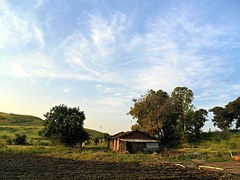A Verdant Vista and Tourist Attraction?

The Village of Mawlynnong
India is known for its hidden gems of beauty, for its modest realms of serenity. Mawlynnong is a village located in the East Khasi Hills district in Meghalaya; it is a minute village, with only about 500 residents. However, despite its locational obscurity and minuscule population, this unassuming village has still managed to make national headlines.
The hamlet of Mawlynnong has been considered the cleanest village in India—and in Asia; in this quaint village, plastic is banned in order to preserve the ecological cleanliness, the streets are swept regularly by passionate volunteers, and bamboo dustbins are strategically placed to avoid littering. While littering is the norm in most metropolitan cities, littering is strictly looked down upon in this village; it is perhaps this mentality that keeps the hamlet so delightfully pure and verdant. Moreover, the paths and roadways are lined with delightful flowers, that impart aesthetic qualities to the town.
Residents of Mawlynnong
Furthermore, Mawlynnong is home to the Khasi tribal people, who follow the matrilineal system of society—a system wherein property is handed down from mother to the youngest daughter; moreover, the children take their mother’s surname. The chief occupation of the denizens of Mawlynnong is agriculture, and there is a 100% literary rate (http://megtourism.gov.in/ecodestination.html)! So, not only is this village environmentally conscious, but it is socially progressive as well; and it is perhaps these characteristics that make it such an intriguing village.
Lifestyle of the Khasi Tribes
The Khasi tribes have tried exceptionally hard to maintain the beauty of this village; as said by Baniar Mawroh, a teenage resident of Mawlynnong, “we clean every day because our grandparents and our ancestors have taught us how to clean the village and the surrounding area, because it’s good for our health”. This regard placed on hygiene emerged after a deadly cholera outbreak 130 years ago. Due to the paucity of adequate medical facilities and medicines, cleanliness became absolutely necessary to the survival of the villagers, and to the development of the region. In the words of Khongthohrem, a village resident, “Christian missionaries told our ancestors: you can protect yourself from the plague (cholera) only if you maintain good hygiene, be it at home, with food, on your land, in the village, or for your body”. Indeed, the way in which these locals have respected and protected their environment from harm is commendable; however, their pristine surroundings may be threatened by external influences.
Threats to Mawlynnong’s Beauty
After the first road to this remote village was constructed twelve years ago, a journalist from Discover India travel magazine wrote an article about its wonderful and rare cleanliness. While this may seem like an admirable initiative, its effect was counterproductive—it induced hundreds of tourists to visit, degrading the picturesque vistas and simple lifestyles. In the words of Rishot Khongthohrem, a guesthouse owner, “Now there is noise pollution. I’ve talked to the village council which has written to the government to build a new parking lot further away”. There have also been complaints about a lack of privacy—and that their daily activities are being photographed and made a spectacle out of. Now, in the peak travel season, Mawlynnong receives up to 250 tourists per day; indeed, its population has distended by a whopping 50 percent. And this increasing population poses the serious risk of doing away with the charming, exceedingly ecofriendly ways of living of the Khasi tribes.
Conclusion
The village of Mawlynnong is undoubtedly a precious jewel of India, which must be saved and respected by fellow Indians. So, we should strive to ensure that its beauty is preserved. As reported by The Hindu, “While the pristine village is proud of its achievements, some believe it must limit visitor numbers to protect the well-being of its inhabitants”. And this can be achieved by raising awareness about the negative impacts tourists can have on this modest village. In addition, restrictions should be placed on the number of tourists who arrive per day; rules should also be implemented to ensure that cars and other vehicles are parked at a safe distance from the houses of the inhabitants. Visitors should also be encouraged to make as little noise as possible, and to arrive in pairs or in small families–so that this silent village is not heavily affected by the influx of tourists from across the nation. And lastly, as said by the Prime Minister Narendra Modi , “I was amazed to know that there is such a village in remote north-east, Meghalaya which is so passionately carrying the mission of cleanliness for years”.
[Image Attribute: ultimatebipin]